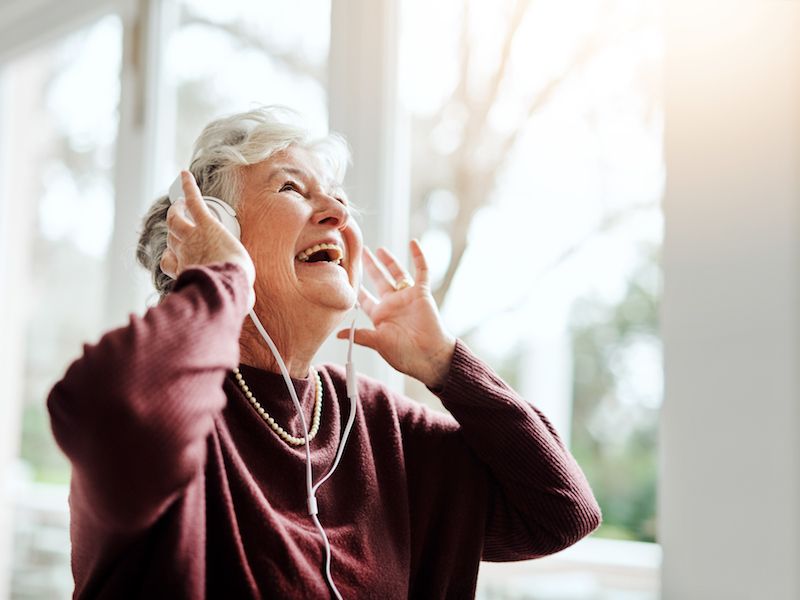
Noise-related hearing loss doesn’t just impact individuals who work in loud settings, such as construction workers or heavy metal roadies. It doesn’t even need to be work-related, recreation-related noise exposure can be harmful, too. What kind of exposure are we talking about? Loud sounds heard through headphones, whether it’s gaming, streaming video, music, or even an audiobook with the volume cranked up.
You may be surprised to learn that a mobile device can go that loud. The average pain threshold for human hearing is around 150 db which is in the range of these devices. This is the volume at which noise begins to literally cause pain in your ears. So what can you do to protect against this sort of noise-related hearing loss?
The volume level here is important. Listen with the volume at or below 60% for 60 minutes or less at a stretch (how long you listen for also matters), this is called the 60/60 rule.
Your Hearing Aids Can be Set up For Listening to Music
Be sure, if you’re utilizing hearing aids, you don’t try to drown out other sounds by cranking your streaming music up too loud. And there are much healthier ways to listen to music so consult us about that as well. Hearing aids aren’t created to increase the quality of music like they do with voices so if really like music, you might have discovered this. We might be able to make adjustments to reduce feedback and noise while boosting some frequency ranges to better the quality of sound while listening to music.
What Are The Right Headphones For You?
When picking out headphones there are many options, particularly if you use hearing aids. It might be a matter of personal choice, but there are some things you should consider there as well.
Over-the-Ear Headphones
While the foam-covered speakers that was included with your old Walkman are basically no longer used, over-the-ear headphones have made a comeback. Often shockingly expensive, they offer lots of color choices and celebrity endorsements, and yes, better sound quality. And unlike those little foam pads, these cover the whole ear, stopping outside noises.
Main-stream wisdom is that these are less dangerous than in-ear headphones because the source of the sound is further from your eardrum. But the truth is they’re frequently capable of much louder volume than the smaller kind, the speakers are much bigger. Noise cancellation can be a helpful thing as long as you’re not losing useful sounds such as an oncoming automobile. That said, because they cancel out outside sound, you can typically lower the volume of what you’re listening to so it’s not loud enough to harm your ears.
Earbuds
The standard earbuds that come with devices such as iPhones are much maligned for their poor quality of sound, even though lots of people still use them because hey, they came with the phone. In addition, with newer devices that don’t have a headphone jack, staying with Apple’s earbuds can simply be easier.
Earbuds also don’t cancel out noise so the downside is, you tend to turn up the sound level. Once again,, though it’s frequently said that earbuds are a problem because you put them in your ear so their speakers are very close to your eardrum, actually volume is the biggest concern.
Noise Blocking Earbuds
Many people choose earbuds with a rounded, rubbery tip both because they’re more comfortable than traditional earbuds and better at stopping outside sounds. The rubber conforms to the shape of your ear, producing a seal that blocks other noises from getting in. Not to sound like a broken record, but these have the same downsides as the other two (it’s all about the volume), as well as carrying the same caution as over-the-ear headphones (they can block out warning sounds). Needless to say, these won’t work for you if you have hearing aids.
You may have to check out more than one pair before you find headphones that are what you are looking for. Your expectations, acoustically, will vary depending on what kind of use you normally give them. The essential thing is to find headphones that make it comfortable for you to enjoy at a safe and secure sound level.
How to Make Sure Your Hearing is Protected
Is it Safe, How Can I be Sure? There’s an app for that…If you use a smartphone, you can download the National Institute for Occupational Safety and Health’s free Sound Level Meter app. You can get different apps, but studies has found that the accuracy of these other apps is hit-and-miss (also, for whatever reason, Android-based apps have been shown to be less reliable). That prompted NIOSH to create their own app. You can measure outside sounds with the app, but sounds coming from your device’s speakers can also be measured, essentially, the actual volume of what’s being sent to your ears. It’s a little bit of work, but taking these types of preventative measures can help safeguard your hearing.

